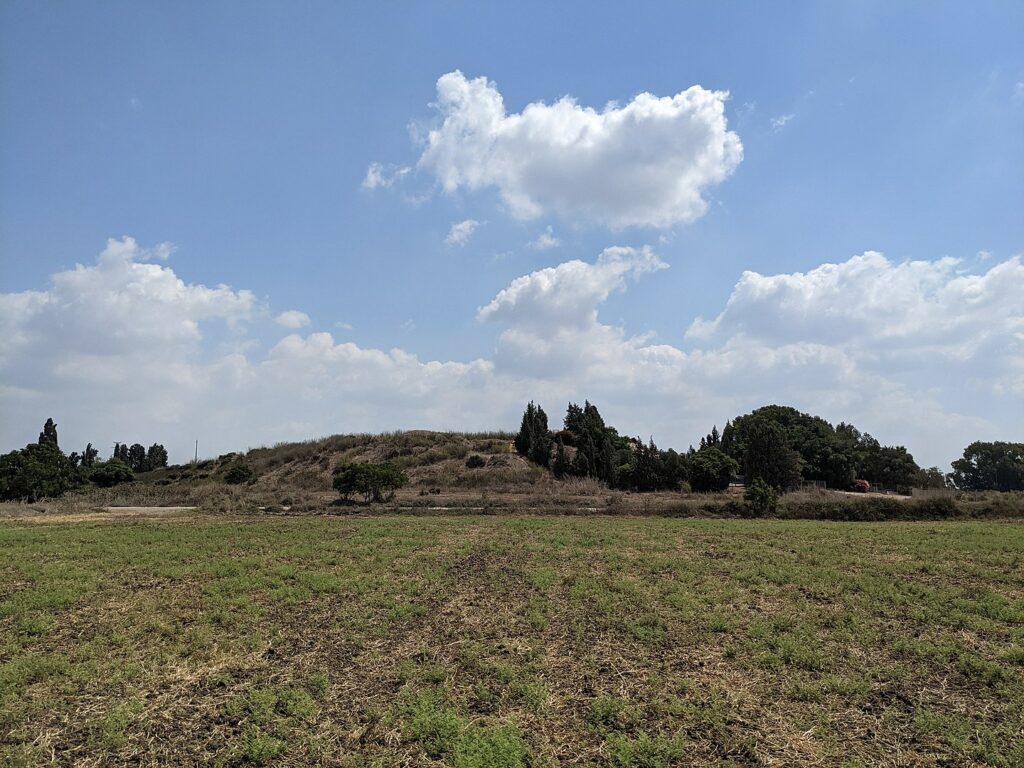Tel Hefer (Arabic: Tel al-Ifshar) is the largest tel along the Alexander River, which drains the Shechem area. The site was inhabited from the Early Bronze Age to the Islamic period. Notable finds include a rich hoard of pottery, basalt grinding stones, and an Egyptian amulet. The tel is located on the eastern Kurkar ridge in the Sharon region, north of Kibbutz Mishmarot, at the point where the Alexander River used to join one of its tributaries, forming an isolated hill. It covers an area of about 40 dunams and rises about 15 meters above its surroundings. In ancient times, boats could navigate the Alexander River, providing the site with access to the sea despite being 4 km inland.

Research history
In 1872, researchers from the British Palestine Exploration Fund (PEF) surveyed the site and suggested that its Arabic name derived from a Turkmen tribe (descendants of nomadic tribes who migrated from Central Asia to the Middle East). In 1935, Professor Benjamin Mazar conducted a survey of the site, followed by Ram Gophna in 1965. Since 1979, excavations at the tel have been carried out as part of the “Archaeological Research of the Hefer Valley,” led by Yosef Porath and Moshe Peleg from the Israel Antiquities Authority and the University at Buffalo, New York.
Mazar suggested identifying the tel with the biblical “Hefer,” mentioned in the Book of Joshua as one of the cities conquered by the Israelites (Joshua 12:17). This identification led to the entire region being named the “Hefer Valley.” Albright argued that “Hefer” is located east of the site and proposed that Tel Hefer was the settlement of the Hefer family from the tribe of Manasseh (Joshua 17:2). Professor Shimon Applebaum posited that the Roman-Byzantine remains at the tel are remnants of a Samaritan village mentioned in the Talmud.
Tel Hefer During the Canaanite Periods
The earliest evidence of settlement at the site dates back to the Early Bronze Age. Sections of walls and typical storage jars from Early Bronze IIB (3300-3100 BCE) have been uncovered. The settlement flourished during Middle Bronze IIA (1710-1590 BCE). However, the architectural remains from this period were challenging to identify due to secondary use and destruction during the Late Bronze Age and Byzantine periods. Numerous residential buildings with courtyards, likely featuring stone ovens, were found. A large structure in the eastern part of the tel, possibly a temple or another public building, was destroyed by fire. It was rebuilt shortly after its initial destruction but was again consumed by a widespread fire that the excavators identified, which destroyed the food storage and the public building.
Several areas within Tel Hefer revealed findings attributed to the Late Bronze Age, during the Egyptian rule over Canaan. From the 15th-14th centuries BCE, multiple buildings, granaries, storage facilities, and imported goods indicating trade with Cyprus were uncovered. In the final stage of this period, around 1200 BCE, the storage facilities were completely burned. Artifacts from this period include an Egyptian amulet, Asherah figurines, and a rich cache of pottery. The cause of the destruction at the end of the period remains unknown. Excavators have proposed several explanations: a conquest by one of the Pharaohs (19th-20th Dynasties), an invasion by the Sea Peoples, or battles against the Israelite tribe of Manasseh.
Tel Hefer in the First Millennium BCE
During the Iron Age, Tel Hefer was sparsely populated. Excavations revealed several storage facilities, grain silos, and basalt grinding stones, indicating a flour industry. The settlement was likely destroyed in 732 BCE during the conquest of Tiglath-Pileser III, King of Assyria. No architectural remains from the Persian and Hellenistic periods were found at the site, though numerous pottery shards from these periods were discovered in pits on the western slope. Excavators believe that remnants of a small settlement from these periods may still be uncovered.
Tel Hefer from the Classical Period to the Arab Conquest and Evidence of Kosher Eating
During the Roman and Byzantine periods, the settlement area expanded significantly, especially to the north and east of the tel. Excavations uncovered two main buildings containing oil lamps, wooden and metal objects, and animal bones. An archaeozoological analysis of the animal bones used for food suggests a population change. Initially, the inhabitants consumed kosher animals (Samaritans and Jews), but by the 6th century, pig bones predominated, indicating a Christian settlement. Excavators speculated that the population change might be related to the Samaritan revolt in 529 CE. The settlement was destroyed in the 7th century, likely due to the Arab conquest in 638 CE.
Sources:
Porath and Paley, 1990. Tel Hefer-1989. Hadashot Arkheologiyot 95. 43-44 (Hebrew)
Porath and Paley, 1990. Tel Hefer-1990. Hadashot Arkheologiyot 99. 29-31 (Hebrew)
SAMUEL M. PALEY, YOSEF PORATH. Hefer, Tell. In Stern, E. (ED). 1993.. Encyclopedia of Archeological Excavations in the Holy Land. Vol 2. Pp 609-614. The Israel Exploration Society. Carta. Jerusalem.
Biblical Hiking map


